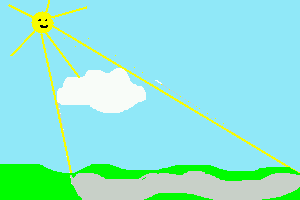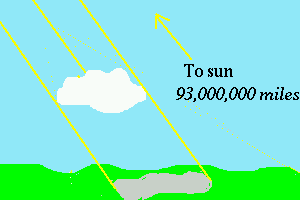
At the end of each section there are some questions, and you are asked
to discuss several of them. Some people find the questions confusing, because
they tend to be open-ended, without a Right Answer. One teacher
group said
We are not sure if this is what you were looking for, but please
email us and let us know if we need to anwer the questions over. Please
give us some guided questions if we totally missed the mark, but we don't
think we did.
Another group said: Don't make fun of us if we seem stupid!
Actually, their discussions were excellent.
What we are looking for is that you think about the physics ideas that
are contained in the questions, along with a good discussion of what you
observed and decided.
We also hope that you will make connections with related things
that you see in everyday life. By these rules there can be many different
discussions that are good; there isn't a particular right answer.
Excellent discussions do most of the following:
If the questions are confusing, this may mean that we didn't ask good questions, and we'll try to improve them. But also notice that we don't have to ask a very good question to evoke a good discussion. These questions are intended to provoke a friendly argument in your group; think of them this way, rather than as 'test questions'. The purpose is to get you to think about light. Some of the questions are a bit off the wall; they don't have Right Answers. We are looking for a discussion that shows you are thinking about the subject. In return you can expect to get our discussion in response to yours.
Here is an example of a question and three possible discussions (that we made up).
This is not a very good discussion in several respects. It ignores
part of the question (what about those lights indoors?) and it doesn't
attempt any explanation of why there are no shadows on a very cloudy day
(the explanation of sun-shadows could have been extended to a claim
that on cloudy days and indoors it isn't bright enough
to have shadows -- this at least would be a discussion of the question).
Very disappointing for us is that the discussion makes no reference to anything
said or done in the unit on shadows. In the unit we mentioned brightness
of the sun only as a reason not to look at it; the activity on sharp and
fuzzy shadows gave a very different reason for their origin, having nothing
to do with brightness of the light. No connection was made in the
discussion with any related everyday occurence.
We had to make up this discussion, because we have never gotten one
this bad!
It would prompt us to write back to the group that we need
more thoughts from them, more connections. It would be hard for us to give
substantial comment on this discussion because we see little effort or evidence
behind the conclusions.
A better discussion, but still limited: Shadows made on bright sunny days are really noticeable. They all point in the same direction because the light that causes them is all travelling in the same direction - it's all coming from the sun. There are no shadows on cloudy days. Shadows inside are all over the place. They are confusing.
This discussion starts out well, with a connection to the principle underlying the unit (light travels in straight lines). The observation of direction of shadows is accurate and appropriate and is a good connection with everyday observations. However, the statement about a lack of shadows on a cloudy day is not based on evidence and seems to merely be assumed. The characterization of shadows indoors is not worded very well -- perhaps it was supposed to mean that objects have multiple shadows due to the multiple sources, but it doesn't really say this.
A third possible discussion: Sunlight is all travelling the same
direction, pretty nearly, and then an object blocks all the light from
the region behind it, making a good distinct shadow that is easy to see.
The edges of the shadow are fairly sharp but at very large distances they
become slightly fuzzy (like the flagpole observations we made). This
fuzziness is because the sun looks like a disk (rather than a dot) in the
sky. On a cloudy day, there is still some sunlight getting through
the clouds, but we think that clouds scatter the light making it go in
many directions at the ground, giving fuzzy shadows that are hard to see.
So hard in fact that we had trouble seeing them at first. Even though the
sun makes sort of fuzzy shadows, the sun seems to act more like the clear
light bulb, while the clouds are more like giant frosted light bulbs.
Indoors we notice that a small and relatively distant light gives
distinct shadows (like candle light making flickering shadows on the walls).
But usually there are many lights in a room, giving overlapping and faint
shadows, and most of the lights have shades or are themselves large (like
the fluorescent tubes). Shadows indoors are not very good to have
(they make it hard to read and work), and indoor lighting is designed to
avoid them.
We figured out that we could make very good shadows by using a 35
mm slide projector with a blank slide. It's a nice and bright light source,
and all aimed in one direction, and makes very clear shadows.
We hope that you agree that this was a very good discussion. It makes reference to some activities and discussions we did in the unit; it discusses the whole question; it ventures explanations for why some things are observed; it gives an application of the material (why shadows are not seen very much indoors), and an extension (how to make good shadows). Finally, it is worded clearly. We love discussions like this!
Notice, there was nothing in this discussion about direction of shadows as in the preceding answer. It's enough that it was a good discussion; there isn't a single right answer that everyone is supposed to find. Notice too that whether the claims are 'correct' is not so important as demonstrating the Right Process, which means making good observations and measurements, seeing comparisons and connections, and developing the mental tools that will help you understand the world. The type of 'good discussion' we look for in the questions focuses on whether your explanation is consistent with what was observed and discussed in the unit. Of course, building correct content understanding is important, too; we will not let incorrect statements pass unnoticed.
Here is another example. Suppose you were asked:
A useful way to discuss this is to draw a picture. You don't have
to submit pictures, but they are fun and tell us a lot. Some people
draw on paper and then scan it to make a file that can be emailed, but
we find the Microsoft utility Paint to be up to the task of making a simple
sketch (when you save the picture, save it as jpg or gif type -- this makes
for a smaller file). So here is a possible discussion of the question: 
The cloud shadow is somewhat larger than the cloud, because the cloud
is closer to the sun (similar to the activities we did on size of a shadow).
This picture shows how this comes about. The shadow forms on the
ground just like the shadows we made on the screen. It's just on
a much bigger scale than the activities we did.
This is a pretty good discussion -- it would have been nice to have a few more words, and perhaps some thought about how much bigger the shadow is than the cloud itself. But the diagram is very helpful - the lines in the diagram make it clear to us that this person knows that light travelling in a straight line is an important part of this question. Of lesser importance is the fact that this diagram contains some incorrect assumptions. What has been left out of the analysis is that the sun is tremendously farther away than the cloud -- 93 million miles instead of just a few -- so that the cloud really isn't appreciably closer to the sun and the shadow size is exactly the size of the cloud. The relative size and placement of clouds and sun are not the subject of this unit. So we like this discussion because it is making use of the concepts of the shadows unit, while regretting that the group forgot about the relative distances. A group that sent us that picture and discussion might receive this response:
"For the record" here is a more accurate picture.

Your reasoning is good but there are some issues of scale that you
have ignored. You clearly understand that light travels in straight
lines and that fact lets us predict shadows. But the
sun is very far away. All the sunbeams are travelling in the same direction,
to our ability to draw them. The result is that the size of the shadow
is an accurate indicator of the size of the cloud. Clouds are huge!
For some more examples of discussions of the kinds of questions we like to ask, take a look at the Question Board!